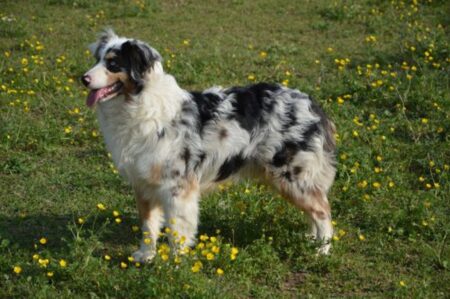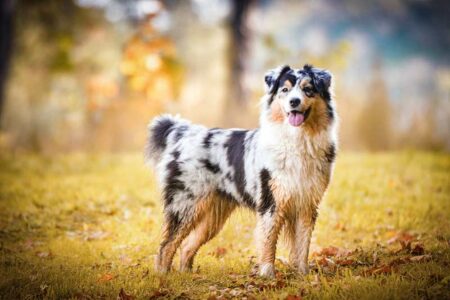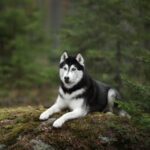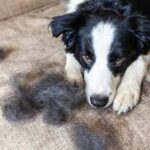
Are Australian Shepherds Hypoallergenic? All You Need To Know
If you’re considering adding an Australian Shepherd (Aussie) to your family but are concerned about allergies, you might be wondering if this Dog breed is hypoallergenic. Let us discuss whether Aussies are hypoallergenic, what this term means, and what to consider if you have allergies and are considering getting a dog. Here is all you need to know if Australian Shepherds are the perfect fit for your lifestyle and health needs.
SEE ALSO: Huskimo: All You Need To Know About This Stunning Mix
Are Australian Shepherds Hypoallergenic? All You Need To Know
Australian Shepherds are not considered to be hypoallergenic. They are considered to be moderate shedders, which means they shed a moderate amount of hair and dander throughout the year.
Despite not being considered hypoallergenic, some people with allergies may still be able to tolerate Australian Shepherds better than other breeds, depending on their specific allergies. This is because allergies are caused by individual sensitivities to specific proteins, and not all Australian Shepherds produce the same proteins in the same amounts.
The Myth About Australian Shepherds
The myth about Australian Shepherds being hypoallergenic likely stems from the fact that they are a popular breed with a beautiful and unique coat and so many people assume that because Australian Shepherds have a thick double coat they must be hypoallergenic but, this is not the case. The thick coat of an Australian Shepherd can trap more allergens than other breeds, making them potentially more problematic for people with allergies.
Another factor contributing to this myth may be that some people mistakenly believe that all dogs with short, wiry coats are hypoallergenic.
It’s important to understand that the proteins that cause allergies in people are not related to the length or texture of a dog’s coat. Even breeds with short, wiry coats can produce allergens that can trigger allergic reactions in sensitive individuals.
And to add to the confusion, some pet shops and breeders may advertise Australian Shepherds as hypoallergenic to attract more buyers. So, it’s important to do your research and consult with your allergist before bringing any pet into your home, regardless of breed.
What Makes People Think Australian Shepherds Shed A Lot?
Australian Shepherds are moderate shedders, but this doesn’t mean they don’t shed a lot. People often think Australian Shepherds shed a lot because:
- Double Coat: Australian Shepherds have a thick double coat, consisting of a soft, dense undercoat and a coarse, medium-length outer coat. This combination of coats traps dander and other allergens, which can make them seem like heavy shedders.
- Climate: Australian Shepherds were originally bred for working in all kinds of weather, which means they have a coat that sheds more in certain seasons to adapt to changes in temperature. They will typically shed more in the spring and fall, as they lose their winter undercoat in preparation for warmer weather.
- Grooming: Australian Shepherds require regular grooming to keep their coats healthy and free of tangles and mats. However, brushing them too infrequently can lead to more shedding, as it can cause dead hair to become trapped in their coats.
- Misconceptions: Some people believe that all dogs with thick, dense coats are heavy shedders, which can contribute to the misconception that Australian Shepherds shed a lot. In reality, the amount of shedding can vary depending on individual dogs, genetics, and other factors.
It’s worth noting that while Australian Shepherds do shed, regular grooming and brushing can help minimize the amount of hair and dander in your home. So, if you’re considering getting an Australian Shepherd but have concerns about shedding, it’s a good idea to talk to breeders and owners to get a better sense of what to expect.
Are Mini Australian Shepherds Good Family Dogs?
Mini Australian Shepherds, also known as Mini Aussies, are often considered good family dogs because they possess many traits that make them ideal for families and here are some reasons why:
- Intelligent: Mini Aussies are highly intelligent and easy to train, making them great for families who want a well-behaved dog and they excel in obedience training, agility, and other dog sports.
- Affectionate: Mini Aussies are known for their affectionate nature and loyalty. They bond closely with their families and enjoy spending time with them.
- Active: Mini Aussies are energetic and enjoy physical activity, which makes them perfect for active families who love outdoor activities such as hiking, running, or playing fetch and they have a lot of energy, so regular exercise is important for their well-being.
- Good with Children: Mini Aussies are generally good with children when raised with them, making them a great choice for families with kids and they are gentle and tolerant of children’s activities, but it’s important to supervise children when interacting with any dog.
Types of Hypoallergenic Dogs
Several breeds of dogs are considered hypoallergenic, meaning they are less likely to cause allergic reactions. Here are a few examples:
- Poodle: Poodles are often considered to be hypoallergenic because they have a non-shedding coat. This means that they shed very little hair and dander, which can help reduce allergic reactions in some people.
- Bichon Frise: Bichon Frise are known for their soft, curly coats that do not shed much. This makes them a popular choice for people with allergies.
- Maltese: The Maltese is another hypoallergenic breed that is popular among people with allergies. They have a single layer of hair, which does not shed much and is considered to be hypoallergenic.
- Schnauzer: Schnauzers are often recommended for people with allergies because they have a wiry coat that does not shed much. There are three sizes of Schnauzers: Giant, Standard, and Miniature.
- Portuguese Water Dog: This breed has a non-shedding coat that is often compared to the Poodle’s.
- Chinese Crested: The Chinese Crested breed has two varieties: hairless and powderpuff. The hairless variety is known for its minimal shedding, while the powderpuff variety sheds a bit more.
- Irish Water Spaniel: The Irish Water Spaniel is a hypoallergenic breed that is known for its intelligence, affectionate nature, and low shedding.
What is So Special About Hypoallergenic Dogs?
Hypoallergenic dogs are special because they provide an opportunity for people with allergies to enjoy the companionship of a furry friend without experiencing the discomfort of allergic reactions here are some reasons why hypoallergenic dogs are special:
- Better Quality of Life: For people with severe allergies, having a pet can seem like an impossible dream. However, hypoallergenic dogs make it possible for these individuals to have a furry companion without experiencing allergic reactions.
- Improved Health: Exposure to pet dander and other allergens can exacerbate asthma and other respiratory conditions. Also, having a hypoallergenic dog can improve the health of allergy sufferers by reducing their exposure to allergens.
- Versatility: Hypoallergenic dogs come in a wide range of sizes, shapes, and personalities, from small lapdogs to larger, more active breeds. This means that people with allergies have many different options to choose from when selecting a hypoallergenic dog.
- Less Cleaning: Hypoallergenic dogs shed less hair and dander, which means less cleaning for pet owners and this can be a major advantage for people who are busy or have limited time for housekeeping.
- Companionship: Hypoallergenic dogs offer the same love and companionship as any other dog but with the added benefit of being less likely to trigger allergic reactions. This makes them ideal for people who want the joy of owning a pet without the downside of allergies.
What Foods Are Australian Shepherds Allergic To?
Australian Shepherds, like other dogs, can be allergic to a variety of foods. Here are some common foods that Australian Shepherds may be allergic to:
- Chicken: Chicken is a common protein source in many dog foods, but some Australian Shepherds are allergic to it and symptoms of a chicken allergy can include skin irritation, scratching, and ear infections.
- Wheat: Wheat is a common allergen in dogs, and Australian Shepherds are no exception. Signs of a wheat allergy can include itching, digestive issues, and respiratory problems.
- Beef: Some Australian Shepherds may be allergic to beef, which is another common protein source in dog food. Symptoms of a beef allergy can include skin irritation, vomiting, and diarrhea.
- Eggs: Eggs are a common ingredient in many dog foods, but some Australian Shepherds may be allergic to them and symptoms of an egg allergy can include skin rashes, itching, and digestive issues.
- Dairy Products: Some Australian Shepherds may be allergic to dairy products like milk, cheese, and yogurt, and symptoms of a dairy allergy can include diarrhea, vomiting, and skin irritation.
- Corn: Corn is a common ingredient in many dog foods, but some Australian Shepherds may be allergic to it. Symptoms of a corn allergy can include skin irritation, itching, and digestive issues.
- Soy: Soy is a common ingredient in many commercial dog foods, but some Australian Shepherds may be allergic to it and symptoms of a soy allergy can include skin irritation, digestive issues, and respiratory problems.
Reasons Why Dogs That Don’t Shed Still Need Grooming
Dogs that don’t shed may not leave a trail of hair around your home, but they still require grooming for a variety of reasons. Here are some reasons why non-shedding dogs still need grooming:
- Hygiene: Like all dogs, non-shedding dogs can accumulate dirt and debris in their coats. Regular grooming helps to keep their coats clean and healthy, which can prevent skin irritation and infections.
- Matted Fur: Many non-shedding breeds have thick, curly coats that can become matted if they are not brushed regularly.
- Skin Health: Regular grooming helps to distribute the natural oils in a dog’s skin, which keeps their skin healthy and prevents dryness and irritation.
- Preventing Allergies: While non-shedding dogs may be less likely to trigger allergies in some people, they can still carry allergens like dander, dust, and pollen in their coats. Regular grooming can help to remove these allergens.
Understanding Dog Hair and How It Works
Understanding dog hair and how it works can help pet owners better care for their furry friends. Dogs have a hair growth cycle that involves three stages: anagen (growth), catagen (transition), and telogen (rest). During the anagen phase, new hair grows from the follicle, while the telogen phase marks the end of the growth cycle when old hair falls out and new hair begins to grow.
Dogs shed their old hair to make room for new growth and have different types of coats, like single coats, double coats, and undercoats. Single-coated breeds have one layer of hair, while double-coated breeds have a soft undercoat and a coarser outer coat.
The color and texture of a dog’s coat are determined by the hair shafts and the melanin (pigment) in the hair. Some dogs may have multiple colors or patterns in their coats, and the texture can range from coarse to silky. So, different coat types require different grooming techniques.
How To Groom Your Dog At Home
Grooming your dog at home can be a rewarding experience for both you and your furry friend. Here’s how to get started:
Regular brushing is essential for all dogs, regardless of coat type. Choose a brush that’s appropriate for your dog’s coat. For long-haired dogs, start at the ends of the hair and work your way up to the roots. For short-haired dogs, brush in the direction of hair growth.
Most dogs only need to be bathed every few months, unless they get into something messy.
Ear infections are common in dogs, so it’s important to keep their ears clean. Use a soft cloth or cotton ball to gently wipe away dirt and wax from the outer ear. Never insert anything into the ear canal.
Trimming your dog’s nails is important for their comfort and health. Use a dog-specific nail clipper, and trim the nails just above the quick (the pink part of the nail). If you’re unsure, ask your vet for guidance.
SEE ALSO: Dogs Chewing Paws and Nails: Why And How to Stop It
FAQs
Q. How hypoallergenic are Australian Shepherds?
Australian Shepherds are not hypoallergenic, they are moderate shedders. Their coat, while beautiful, can trap dander and allergens, making them unsuitable for some allergy sufferers.
Q. Do Australian Shepherds shed badly?
Australian Shepherds do shed, but not as badly as some other breeds. They are considered moderate shedders and require regular brushing to maintain their coat and reduce shedding.
Q. Can you still be allergic to hypoallergenic dogs?
Yes, you can still be allergic to hypoallergenic dogs as they are not completely allergen-free. Allergens are not just found in dog hair, but also in their saliva, urine, and dander.


